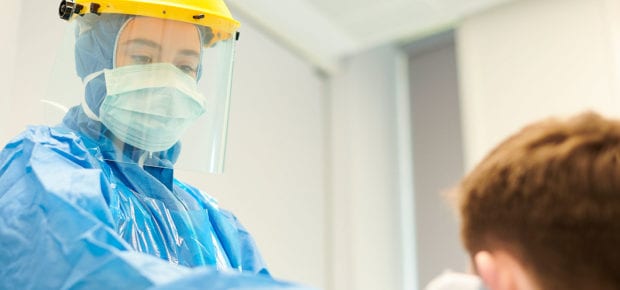May 5, 2020
Researchers are increasingly learning that one of the reasons that COVID-19’s spread is so powerful is because of its airborne potential. As such, the ability for doctors and frontline healthcare workers to use masks and face shields to protect themselves and their patients from the illness is crucial to stopping the spread. Additive manufacturing technologies such as 3D printing are helping keep doctors and their patients safe in the face of high demand and short supply — one mask at a time.
Technologists are employing innovative 3D printing technologies that produce masks and shields at a faster rate than some traditional manufacturing procedures.
IEEE Member Samantha Snabes is one of those technologists, working with healthcare providers in Austin and Houston in the U.S. and Puerto Rico.
“Providers need this equipment now, and additive manufacturing has stepped in to fill the gap as production scales up through distributed manufacturing around hospitals,” says Snabes. “We are energized and inspired by the mass mobilization of 3D printing to tackle COVID-19 head-on by providing protective gear to medical personnel, medical equipment to aid victims and filling gaps in supply chains.”
Additive manufacturing designs and produces products using computer-aided design software or 3D object scanners. Traditional manufacturing typically carves or shapes an already existing material called injection molding, while additive manufacturing layers geometric shapes with precision until the object is created.
“3D printing is ideal to bridge short-term supply gaps, because it allows for on-demand manufacturing, rapid changes and customizations to address the needs of different doctors, hospitals, and personal protection equipment users around the country,” says Snabes. “As changing requirements and changing realities make it difficult to only use one single solution, 3D printing offers mass customization for the same or similar costs per unit. As many platforms are modular or open-source, if used for in-house or on-demand manufacturing, they provide the ability to be quickly modified to support production requirements.”
Snabes stresses that all 3D-printed pieces for face shields have been vetted by healthcare professionals, and the engineers are only creating solutions that have been specifically requested. But that doesn’t mean the engineers and designers aren’t getting creative with their designs.
“3D printed designs are uniquely able to customize to supplies on hand,” says Snabes. “People are getting really creative, especially since stock of clear plastic sheeting is hard to come by. Creative designers are coming up with solutions that use sheet protectors, for instance, as the visor for the face shields.”
See also Lessons Learned by NYC Makers Producing Personal Protective Equipment for Medics
Another benefit to 3D printing face shields is their sterilization potential. While the research is still limited, Snabes has learned that a face shield band printing with durable plastic called Polyethylene terephthalate, may be able to withstand sterilization upwards of 10 times. Being able to clean and reuse masks more frequently means that doctors can continue to save lives while the supply demand levels out.
Looking forward, Snabes predicts this will not be the last time additive manufacturing will be needed or utilized to support emergency situations.
“There may be a push for more distributed manufacturing tools, operators and raw materials globally so that when it makes sense, additive manufacturing can satisfy short-term gaps in critical supplies that can’t be met by injection molding,” says Snabes.
In the meantime, we are thankful for the engineers who are overseeing and developing 3D printing technologies that keep our healthcare professionals safe during this demanding time.






 Meaningful Momentum or Running in Place?
Meaningful Momentum or Running in Place? AI Through Our Ages
AI Through Our Ages Liquid Infrastructure: Our Planet's Most Precious Resource
Liquid Infrastructure: Our Planet's Most Precious Resource The Impact of Technology in 2025
The Impact of Technology in 2025 Quantum and AI: Safeguards or Threats to Cybersecurity?
Quantum and AI: Safeguards or Threats to Cybersecurity? Why AI Can't Live Without Us
Why AI Can't Live Without Us Bits, Bytes, Buildings and Bridges: Digital-Driven Infrastructure
Bits, Bytes, Buildings and Bridges: Digital-Driven Infrastructure Impact of Technology in 2024
Impact of Technology in 2024 Emerging AI Cybersecurity Challenges and Solutions
Emerging AI Cybersecurity Challenges and Solutions The Skies are Unlimited
The Skies are Unlimited Smart Cities 2030: How Tech is Reshaping Urbanscapes
Smart Cities 2030: How Tech is Reshaping Urbanscapes Impact of Technology 2023
Impact of Technology 2023 Cybersecurity for Life-Changing Innovations
Cybersecurity for Life-Changing Innovations Smarter Wearables Healthier Life
Smarter Wearables Healthier Life Infrastructure In Motion
Infrastructure In Motion The Impact of Tech in 2022 and Beyond
The Impact of Tech in 2022 and Beyond Cybersecurity, Technology and Protecting Our World
Cybersecurity, Technology and Protecting Our World How Technology Helps us Understand Our Health and Wellness
How Technology Helps us Understand Our Health and Wellness The Resilience of Humanity
The Resilience of Humanity Harnessing and Sustaining our Natural Resources
Harnessing and Sustaining our Natural Resources Creating Healthy Spaces Through Technology
Creating Healthy Spaces Through Technology Exceptional Infrastructure Challenges, Technology and Humanity
Exceptional Infrastructure Challenges, Technology and Humanity The Global Impact of IEEE's 802 Standards
The Global Impact of IEEE's 802 Standards Scenes of our Cyber Lives: The Security Threats and Technology Solutions Protecting Us
Scenes of our Cyber Lives: The Security Threats and Technology Solutions Protecting Us How Millennial Parents are Embracing Health and Wellness Technologies for Their Generation Alpha Kids
How Millennial Parents are Embracing Health and Wellness Technologies for Their Generation Alpha Kids Space Exploration, Technology and Our Lives
Space Exploration, Technology and Our Lives Global Innovation and the Environment
Global Innovation and the Environment How Technology, Privacy and Security are Changing Each Other (And Us)
How Technology, Privacy and Security are Changing Each Other (And Us) Find us in booth 31506, LVCC South Hall 3 and experience the Technology Moon Walk
Find us in booth 31506, LVCC South Hall 3 and experience the Technology Moon Walk Virtual and Mixed Reality
Virtual and Mixed Reality How Robots are Improving our Health
How Robots are Improving our Health IEEE Experts and the Robots They are Teaching
IEEE Experts and the Robots They are Teaching See how millennial parents around the world see AI impacting the lives of their tech-infused offspring
See how millennial parents around the world see AI impacting the lives of their tech-infused offspring Take the journey from farm to table and learn how IoT will help us reach the rising demand for food production
Take the journey from farm to table and learn how IoT will help us reach the rising demand for food production Watch technical experts discuss the latest cyber threats
Watch technical experts discuss the latest cyber threats Explore how researchers, teachers, explorers, healthcare and medical professionals use immersive technologies
Explore how researchers, teachers, explorers, healthcare and medical professionals use immersive technologies Follow the timeline to see how Generation AI will be impacted by technology
Follow the timeline to see how Generation AI will be impacted by technology Learn how your IoT data can be used by experiencing a day in a connected life
Learn how your IoT data can be used by experiencing a day in a connected life Listen to technical experts discuss the biggest security threats today
Listen to technical experts discuss the biggest security threats today See how tech has influenced and evolved with the Games
See how tech has influenced and evolved with the Games Enter our virtual home to explore the IoT (Internet of Things) technologies
Enter our virtual home to explore the IoT (Internet of Things) technologies Explore an interactive map showcasing exciting innovations in robotics
Explore an interactive map showcasing exciting innovations in robotics Interactively explore A.I. in recent Hollywood movies
Interactively explore A.I. in recent Hollywood movies Get immersed in technologies that will improve patients' lives
Get immersed in technologies that will improve patients' lives